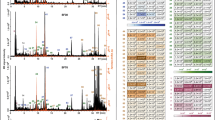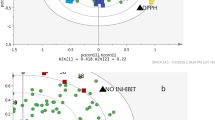Abstract
An improved, reliable and comprehensive method for assessing the quality of the ethyl acetate extract from persimmon leaves (EAPL) and its commercial preparation, Naoxinqing (Brain and Heart Clear capsules), has been developed and validated. Based on HPLC–DAD-ESI-Q-TOF–MS analysis, myricetin-3-O-β-d-galactoside (1), myricetin-3-O-glucoside (2), quercetin-3-O-β-d-galactoside (3), quercetin-3-O-β-d-glucoside (4), quercetin-3-O-(2″-O-galloyl-β-d-galactoside) (5), quercetin-3-O-(2″-O-galloyl-β-d-glucoside) (6), kaempferol-3-O-β-d-galactoside (7), kaempferol-3-O-β-d-glucoside (8), kaempferol-3-O-(2″-O-galloyl-β-d-galactoside) (9), kaempferol-3-O-(2″-O-galloyl-β-d-glucoside) (10), quercetin (11) and kaempferol (12) were identified from 15 batch samples. A HPLC fingerprint analytical method was established. All compounds, with the exception of compound 2, were simultaneously quantified by the single standard to determine multi-components (SSDMC) method, using kaempferol-3-O-β-d-glucoside as the internal standard. The rate of analysis was found to be faster with the SSDMC method than with current acid hydrolysis method (Pharmacopoeia of the People's Republic of China 2015 edition) and the results were more intuitive and reliable. Three-dimensional principal component analysis revealed that there were similar characteristics in persimmon leaf from same district. Analysis of the myocardial cell protection activity of 11 monomeric compounds showed that compounds 12, 11 and 10 were the main active ingredients that produce pharmacologic functions in EAPL. Among these compounds, the bioactive constituent of myricetin-3-O-β-d-galactoside was determined for the first time in Diospyros khaki. Thus, we have established an effective assessment method that can be applied to the comprehensive quality evaluation of EAPL extract and Naoxinqing capsule.




Similar content being viewed by others
References
Xie CY, Xie ZS, Xu XJ, Yang DP (2015) Persimmon (Diospyroskaki L.) leaves: a review on traditional uses, phytochemistry and pharmacological properties. J Ethnopharmacol 163:229–240
Khan MM, Tran BQ, Jang YJ, Park SH, Fondrie WE, Chowdhury K, Yoon SH, Goodlett DR, Chae SW, Chae HJ, Seo SY, Goo YA (2017) Assessment of the therapeutic potential of persimmon leaf extract on prediabetic subjects. Mol Cells 40:466–475
National Pharmacopoeia Commission (2015) Pharmacopoeia of the People’s Republic of China, vol 1. Chinese Medical Science and Technology Press, Beijing, pp 1380–1382
Jin Y, Zhang WY, Meng QF, Li DH, Garg S, Teng LR, Wen JY (2013) Forced degradation of flavonol glycosides extracted from Ginkgo biloba. Chem Res Chin Univ 29(4):667–670
Kawakami K, Shibukura Y, Kanno T, Furuki T, Aketa S, Hirayama M (2011) Identification of 2″-galloylated flavonol 3-O-glycosides accumulating in developing leaves of persimmon. Phytochem Anal 22:403–410
Heras ML, Quifer-Rada P, Andrés A, Lamuela-Raventós R (2016) Polyphenolic profile of persimmon leaves by high resolution mass spectrometry (LC-ESI-LTQ-Orbitrap-MS). J Funct Foods 23:370–377
Gao W, Wang R, Li D, Liu K, Chen J, Li HJ, Xu XJ, Li P, Yang H (2016) Comparison of five Lonicera flowers by simultaneous determination of multi-components with single reference standard method and principal component analysis. J Pharm Biomed Anal 117:345–351
Le VNH, Khong TQ, Na K, Kim KT, Kang JS (2017) An optimized HPLC-UV method for quantitatively determining sesquiterpenes in Nardostachyos Radix et Rhizoma. J Pharm Biomed Anal 145:406–413
Huang SW, Wang W, Zhang MY, Liu QB, Luo SY, Peng Y, Sun B, Wu DL, Song SJ (2016) The effect of ethyl acetate extract from persimmon leaves on Alzheimer’s disease and its underlying mechanism. Phytomedicine 23:694–704
Gao XY, Jiang Y, Lu JQ, Tu PF (2009) One single standard substance for the determination of multiple anthraquinone derivatives in rhubarb using high-performance liquid chromatography-diode array detection. J Chromatogr A 1216:2118–2123
Zhao YF, Wang PP, Chen SS, Han CJ, Yan QT, Zheng LT, Jia J, Ren ZX, Zhen XC (2017) Dihydromyricetin protects against cerebral ischemia/reperfusion injury via suppressing microglia-mediated neuroinflammation and activation of ERK1/2-CREB signaling pathway. J Funct Foods 33:76–84
Xue YL, Miyakawa T, Hayashi Y (2011) Isolation and tyrosinase inhibitory effects of polyphenols from the leaves of persimmon, Diospyros kaki. J Agric Food Chem 59:6011–6017
Scharbert S, Holzmann N, Hofmann T (2004) Identification of the astringent taste compounds in black tea infusions by combining instrumental analysis and human bioresponse. J Agric Food Chem 52:3498
Han JT, Bang MH, Chun OK, Kim OD, Lee CY, Baek NI (2004) Flavonol glycosides from the aerial parts of Aceriphyllum rossii and their antioxidant activities. Arch Pharmacal Res 27(4):390–395
Zehl M, Braunberger C, Conrad J, Crnogorac M, Krasteva S, Vogler B, Beifuss U, Krem L (2011) Identification and quantification of flavonoids and ellagic acid derivatives in therapeutically important Drosera species by LC-DAD, LC-NMR, NMR, and LC-MS. Anal Bioanal Chem 400:2565–2576
Zhai HL, Li BQ, Tian YL, Li PZ, Zhang XY (2014) An application of wavelet moments to the similarity analysis of three-dimensional fingerprint spectra obtained by high-performance liquid chromatography coupled with diode array detector. Food Chem 145:625–631
Wang F, Wang B, Wang L, Xiong ZY, Gao W, Li P, Li HJ (2017) Discovery of discriminatory quality control markers for Chinese herbal medicines and related processed products by combination of chromatographic analysis and chemometrics methods: Radix Scutellariae as a case study. J Pharm Biomed Anal 138:70–79
Lee J, Kim JH (2016) Kaempferol inhibits pancreatic cancer cell growth and migration through the blockade of EGFR-Related pathway in vitro. PLoS One 11:e0155264
Guo L, Zeng SL, Zhang Y, Li P, Liu EH (2016) Comparative analysis of steroidal saponins in four Dioscoreae herbs by high performance liquid chromatography coupled with mass spectrometry. J Pharm Biomed Anal 117:91–98
Huang SW, Qiao JW, Sun X, Gao PY, Li LZ, Liu QB, Sun B, Wu DL, Song SJ (2016) Secoiridoids and lignans from the leaves of Diospyros kaki Thunb with antioxidant and neuroprotective activities. J Funct Foods 24:183–195
Acknowledgements
This study was partially supported by Natural Science Foundation of Liaoning Province (20180550371), Liaoning Province Educational Committee Science Foundation for Youths (2017LQN15), Jilin Province Scientific and Technological Development Program of China (20130727010YY).
Author information
Authors and Affiliations
Corresponding author
Ethics declarations
Conflict of interest
The authors declare no conflict of interest.
Additional information
Publisher's Note
Springer Nature remains neutral with regard to jurisdictional claims in published maps and institutional affiliations.
Electronic supplementary material
Below is the link to the electronic supplementary material.
Rights and permissions
About this article
Cite this article
Zhou, Z., Li, N., Zhang, HF. et al. Simultaneous quantitative analysis of 11 flavonoid derivatives with a single marker in persimmon leaf extraction and evaluation of their myocardium protection activity. J Nat Med 73, 404–418 (2019). https://doi.org/10.1007/s11418-018-1274-y
Received:
Accepted:
Published:
Issue Date:
DOI: https://doi.org/10.1007/s11418-018-1274-y




